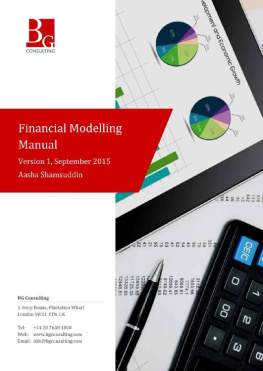Practical Financial Modelling
The Development and Audit of Cash Flow Models
Third Edition
Table of Contents
Copyright
Butterworth-Heinemann is an imprint of Elsevier
The Boulevard, Langford Lane, Kidlington, Oxford OX5 1GB, UK
225 Wyman Street, Waltham, MA 02451, USA
Copyright 2016 Operis Group PLC, Published by Elsevier Ltd. All rights reserved.
Previous editions copyrighted: 2008, 2005
No part of this publication may be reproduced or transmitted in any form or by any means, electronic or mechanical, including photocopying, recording, or any information storage and retrieval system, without permission in writing from the publisher. Details on how to seek permission, further information about the Publishers permissions policies and our arrangements with organizations such as the Copyright Clearance Center and the Copyright Licensing Agency, can be found at our website: www.elsevier.com/permissions.
This book and the individual contributions contained in it are protected under copyright by the Publisher (other than as may be noted herein).
Notices
Knowledge and best practice in this field are constantly changing. As new research and experience broaden our understanding, changes in research methods, professional practices, or medical treatment may become necessary.
Practitioners and researchers must always rely on their own experience and knowledge in evaluating and using any information, methods, compounds, or experiments described herein. In using such information or methods they should be mindful of their own safety and the safety of others, including parties for whom they have a professional responsibility.
To the fullest extent of the law, neither the Publisher nor the authors, contributors, or editors, assume any liability for any injury and/or damage to persons or property as a matter of products liability, negligence or otherwise, or from any use or operation of any methods, products, instructions, or ideas contained in the material herein.
ISBN: 978-0-08-100587-3
British Library Cataloguing-in-Publication Data
A catalogue record for this book is available from the British Library
Library of Congress Cataloging-in-Publication Data
A catalog record for this book is available from the Library of Congress
For information on all Butterworth-Heinemann publications visit our website at http://store.elsevier.com/
Publisher: Nikki Levy
Acquisition Editor: J. Scott Bentley
Editorial Project Manager: Susan Ikeda
Production Project Manager: Nicky Carter
Designer: Mark Rogers
Typeset by TNQ Books and Journals
www.tnq.co.in
Printed and bound in the UK
Dedication
To Rebecca, Jack, and Jeremy: Modelling is nothing to do with catwalks.
About the Author
Jonathan is the director of training at Operis TRG Ltd, the training division of Operis Group plc. He has extensive experience of skills and knowledge transfer in this field and has been involved in delivering modelling training since the early 1990s. He has since developed the Operis portfolio of financial modelling courses, which he has delivered to finance and management professionals around the world. He is a member of the European Spreadsheet Risks Interest Group (EuSpRIG), the international financial modelling thought leaders forum. Jonathan holds an MBA from the East London Business School, and a Bachelor of Education degree. He was appointed as a Visiting Fellow at the Lord Ashcroft International Business School in 2011.
Preface to the Third Edition
There are far more books on the subject of financial modelling now than when the first edition of this book appeared back in 2005. Ranging from academic tomes full of financial algorithms, to books on company valuation, modelling risk, cash flow forecasting, corporate finance, through to applied Excel techniques and VBA programming, the financial analyst now has a good chance of finding a book relating directly to their modelling needs.
The financial modelling environment has also matured: a range of methodologies are now available, such as the Operis method as set out in this book, and the very similar FAST, SMART and BPM systems, amongst others. These methodologies are used by the increasing number of specialist financial modelling firms, such as Operis, Financial Mechanics, F1F9 and Corality, as well as by the large accounting and consulting firms. Although the financial regulators are still unwilling to provide guidance, here in the United Kingdom we have recently seen the publication of the Review of Quality Assurance of Government Analytical Models (the Macpherson report, HM Treasury 2013) with guidelines for spreadsheet modelling practice across the whole of the UK public sector. The Institute of Chartered Accountants of England and Wales is promoting its Twenty Principles for Good Spreadsheet Practice .
Financial modelling practitioners are generally better trained and have greater experience than before. Industry groups and forums such as the European Spreadsheet Risks Interest Group (EuSpRIG) have reinforced the message that modelling is an inherently error-prone activity and good modellers routinely employ a range of checks and controls in their work. The focus has shifted away from model development and much more into model audit and review. The question posed in the preface of the first edition of this book remains the same: is this model right? Previously we answered this question by exploring and understanding the modelling methodology needed to develop our own model. This time we work more on the assumption that someone else has produced the model. It may or may not conform to a standard methodology, but now we need the tools and techniques to provide the assurance to the model owners or sponsors.
Preface to the Second Edition
There have been two main incentives to produce a second edition of this book. The first and perhaps most obvious reason is the introduction of Microsoft Excel 2007, with its radical new appearance. Microsofts market research suggested that the vast majority of Excel users appear to treat the software as a gloried tool for producing tables, and the new results-oriented user interface is designed to make them far more efficient at doing so. Unfortunately for anyone with a reasonable level of competence in Excel there is a substantial learning curve, and some of the most straightforward commands have become frustratingly obscure. Although the underlying Excel functionality remains largely unchanged, the new command sequences and shortcuts have entailed a substantial revision of many of the command sequences used in this book.
The second reason for a new edition is rather less obvious but I believe of greater significance. I have previously been critical of the way in which organisations and individuals are able to generate financial spreadsheets and models in an uncontrolled way and it would now seem that there is a growing recognition of this problem by the regulatory authorities. In the United States, the SarbanesOxley Act (2002) sets out a legal framework for financial reporting and the use of risk controls and this is having a major impact on the way organisations manage their spreadsheets. Historically, European regulators operate by principles rather than by rules but there are already signs that the Financial Services Authority and its European Union equivalents are being influenced by this legislation. It has been gratifying to note that the modelling methodology set out in this book is effectively a compliance process, and that the risk controls can be mapped directly to the model structure discussed in .













